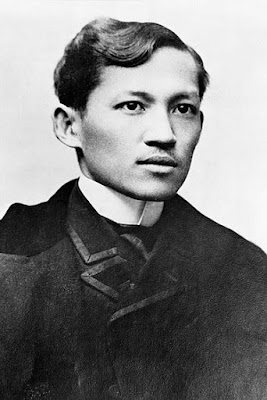Our National Hero is a man of many professions. He was an ophthalmologist, a writer, and a journalist - to name a few.
Unknown to many, Jose Rizal was also a perito agrimensor or an expert surveyor. I learned this fact in one of my first geodetic engineering subjects (GE 10 perhaps).
While studying at Universidad de Santo Tomas, Rizal enrolled in Ateneo Municipal de Manila (now called as the Ateneo de Manila University) and took up a vocational course in land surveying. In 1878, he took and passed the exam for land surveyors at the age of 17 years old. He was too young for the license so he only received the title Perito Agrimensor or expert surveyor in 1881.
One possible reason why Rizal wanted to be a surveyor is his future plan of managing his family's land in Calamba. Land surveyor is a useful profession for a member of a landed class like Rizal.
He was not able to use his land surveying expertise in Calamba because he immediately went to Europe after finishing his higher education in Manila. Rizal was only able to practice his surveying profession when he was exiled in Dapitan.
Our national hero put his time in Dapitan to good use. He served as the doctor for Dapitan's sick and the teacher for the youth. He also served as the town's perito agrimensor.
According to Austin Craig in his book Lineage, Life, and Labors of José Rizal, Philippine Patriot:
Father Francisco Sanchez, Rizal's instructor in rhetoric in the Ateneo, made a long visit to Dapitan and brought with him some surveyor's instruments, which his former pupil was delighted to assist him in using. Together they ran the levels for a water system for the town, which was later, with the aid of the lay Jesuit, Brother Tildot, carried to completion.
The water system that Rizal built sourced its water from a place called Linaw, which was at the mountain near his property in Talisay, Dapitan. From Linaw, the water flows through clay pipes for 2 kilometers downstream to Barangay Sinonoc. The clay (brick) pipes were manufactured by Rizal and his students using indigenous materials and manual method.
The clay pipes that Rizal manufactured had bores like that in a gun barrel to increase the speed of water flow. He also applied his artistic skills by sculpting a lion's head at the end of the pipeline, possibly copying similar sculptures in Europe.
 |
| (University of Michigan Library) |
Rizal's engineering feat earned the praise of many, one of whom is a supervising engineer in the Bureau of Public Works of the American colonial government, H. F. Cameron who said:
When one considers that Doctor Rizal had no explosives with which to blast the hard rocks and no resources save his own ingenuity, one cannot help but honor a man, who against adverse conditions, had the courage and tenacity to construct the aqueduct which had for its bottom the flutted tiles from the house roofs, and was covered with concrete made from lime burned from the sea coral. The length of this aqueduct is several kilometers, and it winds in and out among the rocks and is carried across gullies in bamboo pipes upheld by rocks or brick piers to the distribution reservoir.
The water system that Rizal built is no longer operational and was lost due to neglect.
Jose Rizal also used his surveying expertise when he created the relief map of Mindanao. The purpose of that map is to teach his students about geography. He based the relief map on Carta Hydrographica y Chorographica de las Yslas Filipinas (Hydrographical and Chorographical Chart of the Philippine Islands) of the Jesuit priest Pedro Murillo Velarde.
Jose Rizal's relief map was preserved and is now treasured by the citizens of Dapitan. It is one of the surviving evidence of our National Hero's expertise as a land surveyor.
 |
| (Wikimedia) |
Jose Rizal is a land surveyor, a PERITO AGRIMENSOR. This fact should be highlighted and be announced to the whole country. A memorial should be built about it! Oh how good it is to see a statue of Jose Rizal peering through a surveyor's level with one of his students holding the rod.
References:
Lineage, life and labors of Jose Rizal, Philippine patriot: a study of the growth of free ideas in the trans Pacific American territory, by Austin Craig in Gutenberg and University of Michigan Library.
The architect, planner, and engineer in Dr. Jose Rizal by Architect Felino A. Palafox, Jr. in The Manila Times
Sa ningas ng apoy: si Rizal ang dakilang manunubos ng kalayaan henyo, makabayan, bayani at martir by Victor C. Ramos and Erlinda D. Lalic
Grandson of Rizal's Dapitan student: Let's restore historic water system by Gualberto Laput in Rappler
Quarterly Bulletin, Volumes 6-8 (1917) by Philippines. Bureau of Public Works
References:
Lineage, life and labors of Jose Rizal, Philippine patriot: a study of the growth of free ideas in the trans Pacific American territory, by Austin Craig in Gutenberg and University of Michigan Library.
The architect, planner, and engineer in Dr. Jose Rizal by Architect Felino A. Palafox, Jr. in The Manila Times
Sa ningas ng apoy: si Rizal ang dakilang manunubos ng kalayaan henyo, makabayan, bayani at martir by Victor C. Ramos and Erlinda D. Lalic
Grandson of Rizal's Dapitan student: Let's restore historic water system by Gualberto Laput in Rappler
Quarterly Bulletin, Volumes 6-8 (1917) by Philippines. Bureau of Public Works

No comments:
Post a Comment